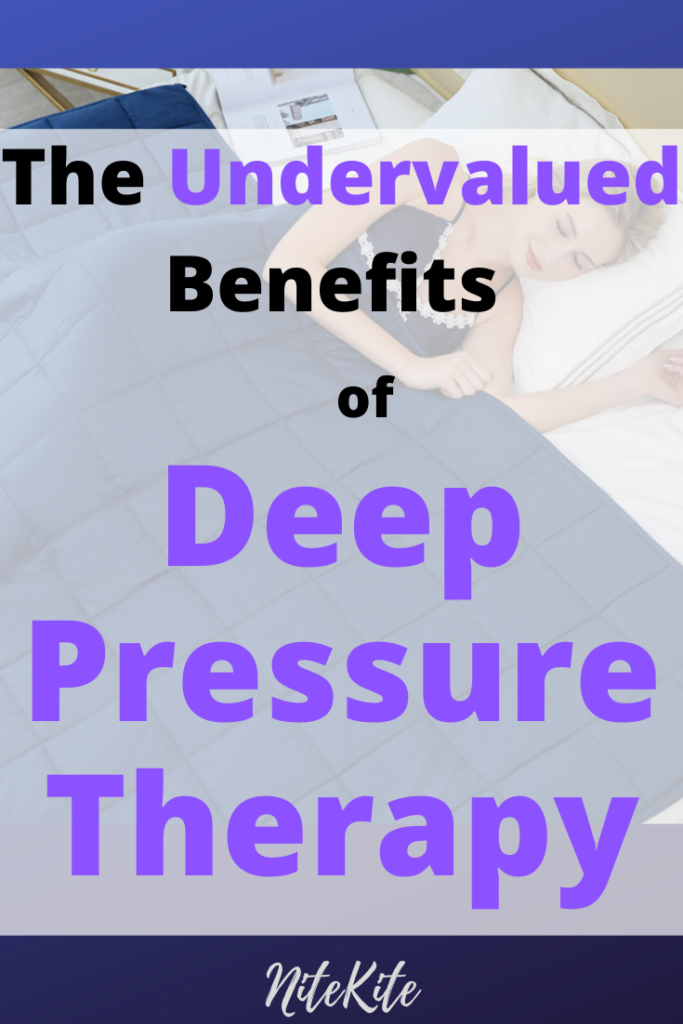- Increased happiness
- Improved social interactions
- Decreased anxiety
- Improved focus
- General sense of enduring calm
- Better sleep
Ok nice list…but what exactly are we talking about here, and what’s it got to do with “Deep Pressure therapy”? Good question.

What is Deep Pressure Therapy ?
To properly address this question, we should delve deeper into the background, and how it came about as a term in therapy circles, and the world of mental health.
Many of us have heard of (and likely thought about having) massage therapy, and its usually in the context of taking a short city break, getting away to a spa for a rejuvenation retreat, out of one’s usual surroundings. For a large proportion of us it’s also something usually given as a gift on a birthday or other special event.
Deep Pressure Touch stimulation is simply described as a “full-on hug to the body” with the intent of relaxing the central nervous system – and it’s been shown to work. Because we all need a hug every once in a while, but wouldn’t it be even better if we could achieve the same sensation at least once a day?

When practiced correctly the therapy triggers a reaction in the body that begins calming the body delivering a sense of peace and relaxation.
Deep Pressure Therapy – The Essentials
Dr. Temple Grandin, a leading researcher in the field of autism (and is also on the autism spectrum herself), set out to investigate the effects of squeezing and hugging on the body after observing the way cows reacted when they were pressed between the sides of a squeezing machine while being led to receive their vaccinations.
She says that she herself recalls yearning for hugs as a child, while at the same time being difficult to hold, as she was not responsive to others approaching in that way. Years later and now a qualified doctor, she wondered “what if there was a way to control the pressure?” These lead her down the path of scientifically testing and applying these theories, where eventually she noticed the positive effects controlled pressure had on other participants.
And that is how scientific researched arrived at the starting point for pressure-delivering devices such as weighted vests and weighted blankets for children on the autistic spectrum.
It was not long until many other people wanted to experience the benefits listed at the top of the article for themselves, and could due to the weighted blanket improvisation –with weights and sizes for all kinds of people.
How Deep Pressure Therapy Works
When were young, we quickly discover the world around us through our five senses. As we enter schooling age, as early as pre-school/nursey, we’re further told about the senses and how they’re used to help us navigate the world.
We’re not told that actually there are 8 main senses – with the other three senses just as important as the obvious ones, but are not as easily manipulated as say, stretching your arm out to touch a wall, or purposefully inhaling the fresh smell of roses.
Vestibular input – our sense of balance, which is also happening in our inner ear
Proprioceptive Input – the use of muscles and body to monitor the body’ position at any given time, so that one has the most accurate information about the world around them
Interoceptive Input – our innate ability to become aware of internal bodily sensations, for example, when you get hungry, you feel a certain hollowness inside the stomach, without actually knowing what’s happening.
The combination of all 8 senses work to navigate you through the world. It is these last three that focus more on balance and positioning, that have been linked to heightened sensitivity to anxiety and stress, when the body is not processing information sufficiently. That leads to restlessness and sleeping problems.
Fight Or Flight And Rest And Digest
The parasympathetic Nervous System
This is the part of the nervous system that is activated when the body is at a resting state. It keeps the body in order, in a kind of regulatory way. Whether it’s digesting food, controlling the heart rate and things that happen “to cool off”.
The sympathetic Nervous System
“If the parasympathetic nervous system is in charge of the body when we’re at rest, the sympathetic nervous system springs into action when we’re on the go”.
This is the system that takes control when were active –or on alert – it manages us through stressful situations such as getting stuck in traffic or feeling anxious about something.
So how does this intertwine with “DPT”?
“For patients with high levels of anxiety or physiological arousal, DPT intervention acts as a calming or focusing agent to increase activity in the parasympathetic division of the autonomic nervous system” – a 2011 study published in the Journal of Medical and Biological Engineering.
Serotonin, Dopamine and the Brain
What the research discovered was that pressing, squeezing, touching – all of these things illicit certain desirable reactions in the bodies of those on the spectrum. But these feelings were already linked to hormones and the brains reward system.
Dopamine and serotonin are hormones released by the brain as “comforters” in the simplest sense – they make the body feel good, in essence. And the research so far has shown that these same hormones are released during Deep Pressure Therapy.
And that’s why DPT is not saved only for those on the autistic spectrum. IT has benefits for all, and does not require one to get a full body massage or other time-consuming activity.
Deep Pressure Stimulation & Weighted Blankets
Now we can all experience deep pressure stimulation / therapy with weighted blankets.





